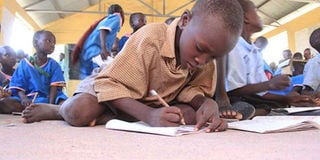Be careful with reopening of schools

Pupils during a lesson at Loiyangalani Primary School in Marsabit County during on March 20, 2014. PHOTO | FILE | NATION MEDIA GROUP
What you need to know:
- The dilemma of whether to open schools or not amid Covid-19 is disturbing to the ministry as well as the parents in view of lack of precedence of such a situation in recent memory.
- To use ICT for teaching and learning would mean that school set-ups be re-engineered in the immediate and intermediate future
- For the practical lessons, laboratories are well spaced by design due to the need for individual use of equipment.
In 1994, the Ministry of Education had a pragmatic and foresighted permanent secretary by the name Simeon Lesrima. One of the issues he was passionate about was the introduction of information and communication technology (ICT) for management purposes at the headquarters, to be cascaded to the provinces and districts and finally to schools for teaching and learning.
Unfortunately, Mr Lesrima faced not only resistance to his idea but also had to contend with inertia from nearly all the senior staff who were expected to champion it.
Before he left office, he told a senior management meeting that he had given up on the idea and that ICT will only be introduced at the ministry when they had all retired or died and replaced by a new generation of change agents.
DISBURSEMENT OF GRANTS
Twenty-six years down the line, faced with the need to deploy ICT in teaching and learning due to the disruption of schooling by the coronavirus, his statement has come to pass.
Granted, the ministry has largely, though incrementally, introduced ICT in the management of examinations, selection of Form One and university joiners, disbursement of grants, teacher management and dispersal of information in real time.
However, the use of ICT for teaching and learning in public schools, universities and mid-level tertiary institutions has lagged behind at the rudimentary level. This is the situation the country finds itself with every sector of the economy forced to shift in a big way to the use of ICT for management of its affairs.
The dilemma of whether to open schools or not amid the smouldering infections is disturbing to the ministry as well as the parents in view of lack of precedence of such a situation in recent memory.
To use ICT for teaching and learning would mean that school set-ups be re-engineered in the immediate and intermediate future. Classrooms in most public schools are congested, with up to 70 students in a room designed for less than 45.
Dormitories are equally crowded. In the coming cold season, students will definitely close windows and doors at night to avoid the chilly conditions. Were one of them to be infected with the virus, the rest would be.
The situation in day schools is better, with social distancing in classrooms. But day scholars mingle with non-students at home and on the way to and from school, risking infection.
The ministry and the schools’ boards of management (BoM) need to consider the following before reopening schools.
ELECTRONIC SCREENS
First, all schools invest in cameras and electronic screens. This will entail decongesting classrooms to possibly a third or a quarter of their current enrollment and be taught in the normal classroom teacher-pupil interaction. The rest can be taught outside in tents or domes or under trees with the use of cameras and large electronic screens.
For the practical lessons, laboratories are well spaced by design due to the need for individual use of equipment. Schools would need to have more shifts on use of labs. They will require to hire cameramen to assist teachers in teaching.
Secondly, schools need to consider pitching several domes that accommodate more than 60 students when social distance spacing of two metres is considered. These could serve as both classrooms and dormitories, depending on how many a school can procure.
Thirdly, the responsibility of students commuting to and from school and home, of necessity, has to be borne by the parents for day scholars, who constitute more than 70 per cent and over 90 per cent of students in secondary and primary schools, respectively.
EMPLOYING MEDICS
Fourthly, boarding schools have to invest massively in healthcare, including by employing medics within the institutions to monitor and attend to students’ medical needs at the shortest possible notice. This will not only pre-empt ailments but also provide psychological comfort and confidence to the students and parents.
Fifthly, the ministry and BoMs have to invest heavily in ICT and adopt its use during and after the pandemic, especially since nobody knows when it will end or be tamed.
Finally, it is difficult to regulate human behaviour, more so children. These measures would be difficult to administer in Kenya with infection rates increasing. Several countries, including France, have had to close schools after a few days of reopening due to a spike in infections. Lebanon, Chile and a few others also had to lock down cities after a few days of reopening.
It would be unwise — nay, fatalistic — for parents to push the government to reopen schools before infections reduce significantly, as was the case in Wuhan. September may be a time to consider. Let us be cautious and patient.
Mr Sogomo is a former Secretary of TSC. [email protected].





